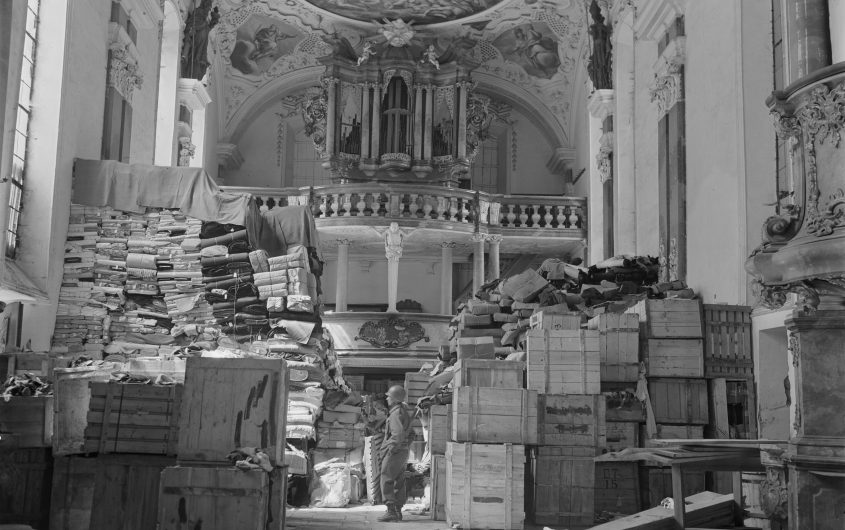
U.S. Department of Defense / Public Domain
Museum Diplomacy at the Crossroads

Romain Faure
Freie Universität Berlin
Romain Faure is deputy head of the International Network University Division of Freie Universität Berlin. He holds a PhD from the Technische Universität Braunschweig, Germany and the Université Paris-1 Panthéon-Sorbonne, France. In his dissertation, published under the title Netzwerke der Kulturdiplomatie. Die Internationale Schulbuchrevision in Europa 1945-1989 (Networks of cultural diplomacy. International textbook revision in Europe; Munich: De Gruyter-Oldenbourg; 2015), he mapped and analyzed the revision activities in Europe during the Cold War. He was a Harry & Helen Gray Reconciliation Fellow at AICGS in 2013.
His current interests revolve around the idea of encouraging a historical dialogue between historians of the Mediterranean. He organized a first workshop on this topic at the Forum Transregionale Studien in Berlin, whose results are available on the Forum’s website.
He is a 2018-2019 participant in AICGS’ project “A German-American Dialogue of the Next Generation: Global Responsibility, Joint Engagement,” sponsored by the Transatlantik-Programm der Bundesrepublik Deutschland aus Mitteln des European Recovery Program (ERP) des Bundesministeriums für Wirtschaft und Energie (BMWi).
The end of 2018 was a busy time on the museum stage. By this I do not refer to any particular million-dollar masterpiece acquisition at the Tate or at the Prado, nor do I hint at blockbuster shows in Berlin or New York. What I have in mind are three episodes, apparently unrelated, but which remind us that art museums are a matter of diplomacy. Three episodes that, when we take them together, give us some clues about the role German-American cooperation might play in the future in shaping the close relationship between cultural heritage and international relations.
First, a transatlantic anniversary. At the end of last year, museum experts from around the globe met in Berlin to celebrate twenty years of the so-called Washington Principles. In 1998, the Washington Conference on Nazi-Confiscated Art convened by the U.S. Department of State was attended by representatives from more than forty countries including Germany and led to increasing restitution of artworks to their former, mostly Jewish, owners. One pillar of this was the releasing of eleven international art restitution principles. Another pillar was the development of provenance research, a discipline that is critical to restitution as it helps trace back the original possessors of artifacts. Nobody ever ignored that some works of art go through dark trajectories before they end up in a gallery. But at least regarding Nazi era lootings, international standards about how to deal with this have started to evolve.
Second, a Franco-Senegalese memorandum. For many years already, discussions have evolved around the globe on the restitution of art illegally acquired under colonial rule. In November 2018, French art historian Bénédicte Savoy and Senegalese scholar Felwine Sarr submitted a report on the restitution of African cultural heritage to President Emmanuel Macron in Paris. In unambiguous terms, the report called for a massive returning of cultural heritage conserved in French museums to African countries. Savoy and Sarr’s recommendations as well as the subsequent restitution of twenty-six royal statues from a Parisian museum to the state of Benin stirred up the public debate and put museums under pressure not only in France, but also in other European countries and especially in Germany.
Third, Chinese investments in Dakar. On December 6, 2018, officials gathered in front of a modern, circular building to inaugurate the new Museum of Black Civilization in the midst of the Senegalese capital. They opened an institution that strives to take leadership in the African museum world and beyond. Its mission is to display and research the histories and cultures of Black civilizations in Africa and elsewhere. And they have unusually high resources to implement their vision. This ambitious dream could come true only with a $34 million gift from the Chinese government, whose efforts to enhance its influence in Western Africa have been steady for more than a decade. Not surprisingly for a museum centered on African cultural heritage, it claims the return of many artifacts that have been stored for years in European, mainly French, museums.
These stories prefigure that the importance of cultural heritage issues in international public diplomacy will increase in future.
What do these three stories tell us? I argue they prefigure that the importance of cultural heritage issues in international public diplomacy will increase in future. Countries in Africa and elsewhere will continue to raise their voices for the restitution of artworks that were stolen during the colonial era. And they will be more successful in achieving their return because former colonial powers as well as new global players are increasingly willing to hearken to their claims—albeit for various reasons. Over the last twenty years, the German-American relationship has been instrumental in setting up art restitution mechanisms. In particular, both countries established a unique network in provenance research. This German-American expertise should now be widely shared with actors from countries engaging in the returning of looted cultural heritage. What is at stake is nothing less than a new global museum landscape, where galleries in former colonized countries are able to receive, conserve, and exhibit several hundreds of returned artworks. From the background of their common experience, German and American stakeholders in culture and politics can together seize the momentum to shape this new, more balanced landscape and thus explore new avenues for transatlantic cooperation in cultural diplomacy.






